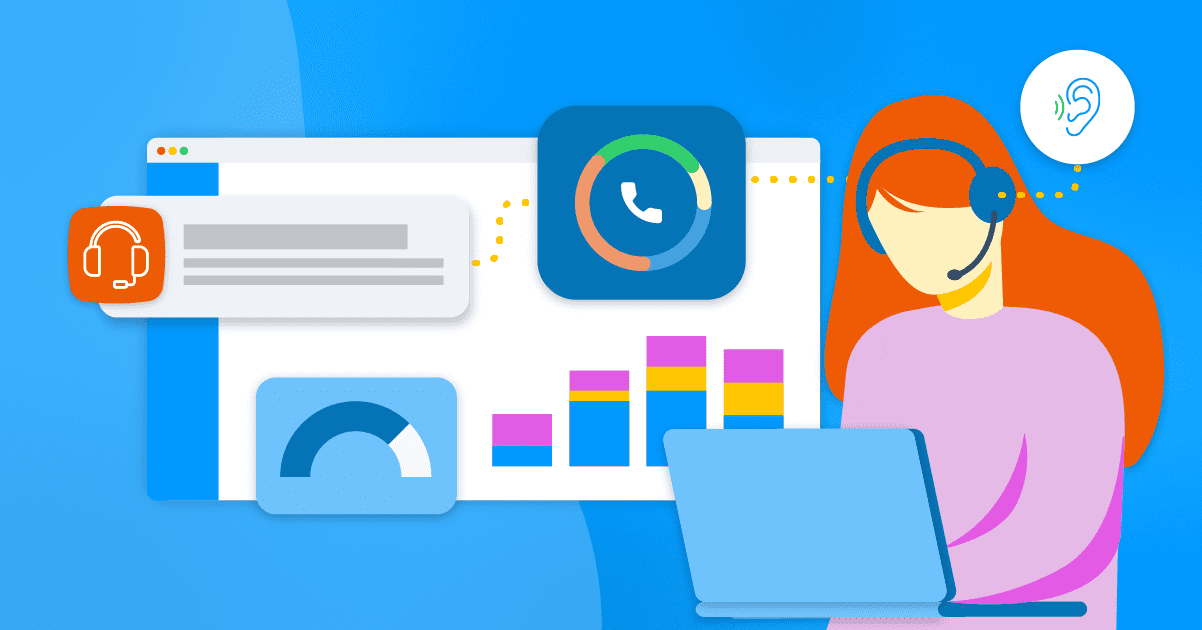How to Boost Sales & Customer Experience with Call Monitoring
Successful organizations lean on call monitoring software to support their global sales and service call center teams. Call monitoring allows CX leaders to gain valuable insight into their agents’ performance on the phones, reduce spend without hindering service, and sustain budget. Ready to learn more?

While sales and customer support teams play different roles within an organization, they do share a commonality - they’re both on the front lines of driving a positive customer experience. And one bad experience could mean a loss of customers, and ultimately, a loss in revenue. Data shows that 73% of customers put having a good experience with a brand above that brand's price and product quality.
With customer retention and revenue on the line, it’s more important than ever to ensure your customer-facing teams have the tools they need to do their job. Successful leaders rely on communications tools like call monitoring software that give them the flexibility they need to listen in on calls and coach where needed.
In this post, we will cover how call monitoring is helping convert more leads, drive higher customer satisfaction, and gain unique insight on market trends.
What is Call Monitoring?
Call monitoring is the process of monitoring customer calls in order to improve the customer experience while also optimizing employee performance. While this contact center feature is typically associated with quality control and training, call monitoring can also be used for a variety of use-cases and across multiple departments.
Who Uses Call Monitoring?
Call monitoring can be leveraged across many departments within your organization. While sales and customer support are most popular, other teams like marketing and product can also find this functionality useful by listening to customer calls to better understand market research trends and product adoption.
Benefits of Using Call Monitoring Software
There are numerous benefits for sales and customer support managers to leverage call monitoring to better manage their teams and drive performance. From identifying problems, training employees, and keeping your finger on the pulse of customer needs, here is a complete list of advantages this communications function can provide you and your teams:
- Reducing Contact Center Costs: Quality training can help reduce your contact center costs. Well-trained agents have the skills necessary to handle their calls efficiently and resolve issues the first time. Excellent coaching can better develop agents, reducing minutes used, improving service, and lowering your overall cost-per-call (The Ultimate Guide for Reducing Contact Center Costs eBook, p.20).
- Ramp New Employees Faster: Cut the onboarding time for new employees with call monitoring. Easily listen in, whisper or barge calls where needed as new reps start to feel more comfortable taking calls on their own.
- Improve Team Performance: Whether you have a team of rockstars or a few reps that are struggling to make it, call monitoring can play a major role in pushing them to the next level. Call monitoring enables your team to re-listen to their calls so they can hear their tone of voice, sales pitch, and responses to customer questions. This is a surefire way for them to understand what can be improved.
- Improve Customer Experience & Enhance Lifetime Value: By making sure that your sales and support teams are handling conversations the right way, you'll be able to quickly see lifts in customer experience. Over time those interactions will evolve into stronger customer relationships that can drive lifetime value up for your business.
- Better Understand Customer Expectations & Market Trends: What better way for you as a leader to keep up with the ever-changing dynamics of your consumers than by listening directly to their feedback? With call monitoring, you’ll be able to stay at the forefront of your customers' needs from both a sales and support perspective.
- Reduce Employee Turnover: Did you know that disengaged employees can cost $3,400 for every $10,000 in annual salary? Call monitoring gives companies an alternative path in boosting employee pride and job satisfaction while reducing expensive employee turnover through customized coaching.
How Sales Leaders Use Call Monitoring to Boost Rep Performance & Drive Revenue
As a sales leader, you are directly measured by the revenue you are driving for the organization. That’s why it’s incredibly important to make sure your team is seamlessly able to convert prospects into paying customers. Call monitoring gives sales reps the ability to better understand who your customers are, their pain points, and how your product or service can solve their problems.
Where to Start
For sales leaders, monitoring phone calls can be a time-consuming task, but it can pay off big time if done right. When driving performance across your entire team, start by focusing on the outliers - the reps who are on top of their game and those who are underperforming. Through this, you’ll want to hone in on the high-yield behaviors. What are your top performers doing well that can easily be replicated across the board?
A few high yield behaviors to look out for:
- Those who can set agendas and stay in control
- Those who can adopt smart product positioning
- Those who can clearly personalize product value
- Those who can handle objections and make it past the gatekeeper
- And of course, those who can convert conversations into demos or customers
Get Your Team Involved
When it comes to call monitoring, don’t keep all the intel to yourself! Instead, bring your sales team along for the process. Enable them to listen to their own conversations - and when possible - bring your entire sales team together to evaluate calls as a group. Your best sales reps will be able to share priceless insight on what works, and what doesn’t - helping to more quickly “coach up” struggling team members.
Setting Clear Expectations
When setting up your call monitoring process, make sure to set clear expectations for your team on what you’re looking for when listening to their calls. Also, lean on analytics to track important details like:
- Lead Origin: Where did the lead come from?
- Customer Sentiment: Was the potential customer engaged? Do they have purchase intent?
- Call Duration: How long was the call and was it productive?
- Buyer Intent: How likely is the potential customer to buy after the call?
- Call Conversion Rate: How successful was the rep/agent at securing a conversion?
- Missed-Call Response Times: How many calls does the rep miss, and how quickly do they attempt to reach that potential customer after missing the call?
How Customer Support Leaders Use Call Monitoring to Improve Customer Experience
As a customer service leader, your goals are different from those of a sales leader. As opposed to directly driving net new revenue for the organization, you may be more focused on enhancing customer service to ensure retention rates are met. With that in mind, you’ll likely be using call monitoring to:
- Improve call center KPIs
- Deliver a more personalized customer experience
- Implement quality control
- Maintain compliance
- Obtain operational efficiency
Having the capability to coach your support agents can help ensure that quality standards are consistently being met. Quality management tools like call recording, whisper, and barge provide valuable insights and direction into your agents’ customer conversations. Make sure that your call center is supported so you can support your customers. Here are four ways to ensure your call monitoring plan is built out for achieving these deliverables:
1. Set Quality Standards
First, you need to determine how success or failure is measured in your agents’ interactions with customers. How they handle calls on the phone impacts the customer experience, which can influence your call center’s KPIs.
- Level of customer satisfaction
- Brand experience
- Agent problem solve ability
- Agent professionalism and attitude
- Agent competency on the product or solution
Start pulling reports to see which agents are reflecting poor levels of customer satisfaction, and begin to listen to their calls to identify coaching opportunities to improve performance going forward.
2. Determine Your KPIs
Key performance indicators, or KPIs, help you benchmark overall and individual call center performance. It can help you drill down on how long agents are on the phone, their productivity levels, and how long a customer sits on hold before hanging up.
Important KPIs to measure include but are not limited to:
- Average Talk Time
- Average Handling Time
- Abandon Rate
- First Call Resolution
- Average Wait Time
- Agent Turnover
Of course, there are numerous other KPIs to measure for. But depending on your organization's needs, you should decide which metrics to focus on and how to benchmark the performance of those KPIs.
Find those agents who have exceptional records and see what they’re doing well via call monitoring or recording. Use those insights to set up a training session with the broader team, or have those high-performing reps facilitate the training so your team can learn from the top.
3. Create Quality Monitoring Scorecards
An important tool coaches use while monitoring calls is quality monitoring, including evaluation forms or scorecards that coaches use to evaluate a rep's performance against company goals or KPIs.
Sometimes called quality assurance scorecards, this tool assigns a score to your agents’ performance and quality of interactions with customers. Scorecards help agents know what level of performance to aim for, and what goals they should work toward when interacting with customers. At the same time, scorecards help leadership like you understand where an individual agent shines and where they could use some additional guidance.
An efficient way to discover which agents would benefit from more coaching is to use automated scorecards. Unlike traditional versions, call scoring is a digital agent scorecard that provides contact center leaders a holistic view of each team members’ performance. Many CPaaS/cloud-communication platforms offer this software, which listens to calls and calculates a score for agents based on predetermined criteria, such as key phrases uttered, words, or pauses in conversation, that it recognizes during any given call.
4. Evaluate the Process
As you monitor calls don’t forget to evaluate your own process and adjust it accordingly to further improve agent performance. Ask yourself questions such as:
- What further tweaks to your coaching methods could you make?
- Have any new discoveries about how to resolve obstacles emerged that everyone should know about?
- Are there any concepts people are still not getting, that everyone needs further instruction to successfully handle?
- Are there any routing strategies causing unnecessary loops or a poor customer experience?
Use monitoring tools like real-time dashboards and call quality scoring to measure agent progression. Leaving conversation feedback and assigning call dispositions can help them gain perspective and correct inconsistencies to help pull inquiries over the finish line.
Improve Company Sales & Customer Experience with Cloud Communications Software
Don’t waste precious time in assuming your sales and support teams are sufficiently handling call volume without contact center software in place. When agents don’t have the right communication tools to use, many pieces of the operation can easily fall through the cracks.
There are many ways to boost your organization’s sales and customer experience with cloud communications. Call monitoring is just one path to increasing sales and revenue, improve agent performance, and reduce costs at the same time. If you’re looking for actionable tactics regarding your call center’s efficiencies with respect to a tight budget, check out our latest eBook: The Ultimate Guide to Reducing Contact Center Costs.
This guide offers insights you can leverage at call centers of any size - in any industry. Inside, you’ll learn how to benchmark your current resources, identify areas to optimize, reduce overall costs and so much more.

